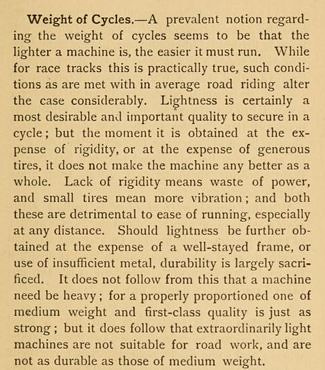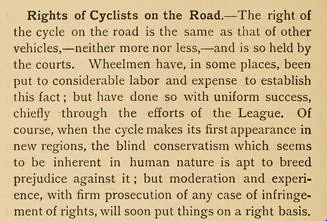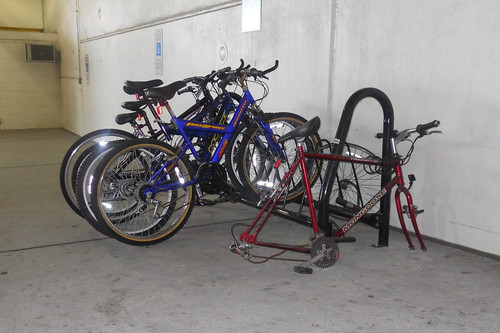When the first diamond frame bicycles became popular in the 1890s they were often called "wheels" - the national cycling association was called the "League of American Wheelmen." We have moved from "wheels" to "bikes," but the bicycles have remained remarkably the same over more than 100 years - elegant in their efficiency and simplicity. And many of the issues that we think are new? They were around then too.
Monday, July 11, 2011
Police Ticketing Sunday Bikers, Haines Point
View Larger Map
Sunday morning at 9 am I took off to Haines Point in Washington DC to do some laps of the trianguler peninsula along the Potomac River. I have seen U.S. Park Police writing tickets at this same location, the junction of Buckeye Drive and Ohio Drive, before on a weekday afternoon but not on a weekend. Anyway, every time I went past on my laps, they had someone different (sometimes groups) stopped. I don't know if they were giving tickets or just warnings, but I suspect they were writing at least some tickets. It can be a $50 ticket if they write one. On my last time through, a bit after 10 am, there were two Park Police vehicles parked up on the median strip in plain sight and they were still pulling cyclists over.
Sunday, July 10, 2011
Weight of Cycles (1890s' View)

A discussion of the all-important bicycle weight question
A prevalent notion regarding the weight of cycles seems to be that the lighter a machine is, the easier it must run. While for race tracks this is practically true, such conditions as are met with in average road riding alter the case considerably. Lightness is certainly a most desirable and important quality to secure in a cycle; but the moment it is obtained at the expense of rigidity, or at the expense of generous tires, it does not make the machine any better as a whole. Lack of rigidity means waste of power, and small tires mean more vibration; and both these are detrimental to ease of running, especially at any distance. Should lightness be further obtained at the expense of a well-stayed frame, or use of insufficient metal, durability is largely sacrificed. It does not follow from this that a machine need be heavy; for a properly proportioned one of medium weight and first-class quality is just as strong; but it does follow that extraordinarily light machines are not suitable for road work, and are not as durable as those of medium weight.A reasonable point of view! The author goes on to offer further analysis~
Since 1892 the advance that has been made in building light bicycles has been absolutely extraordinary, and in less than three years the weight of road machines has been reduced from forty-five to twenty-two or twenty-three pounds. No man, however heavy, need ride a modern wheel of over thirty pounds' weight; very few need ride over twenty-five pound wheels, while the majority of good riders can be safely fitted with wheels that weigh but twenty-two or twenty-three pounds. Of course a good many wheels at even less weight than this will be used on the road, but it should be done with extreme caution. Track racers run from fifteen to eighteen pounds.A modern carbon fiber racing bike that weighed around fifteen pounds would be a costly item, but the track bike described for the 1890s would not have any gears or brakes, which do add weight even on a modern bike. And to save weight, the wheels of an 1890s track bike might well have been made of wood.
Still, one wonders at how quickly steel cycle builders of the 19th century managed to make lightweight track cycles that rival those of a hundred years later in certain measures.

Typical single speed cycle from 1897
Friday, July 8, 2011
More Accurate Video of Dutch Cyclists
The speeded-up version of Dutch commuters that received so much attention
The speeded up version does reduce the "boredom factor" and makes it clear more quickly how many cyclists are moving to and fro in such a business-like way.
Now however the blogger has released a real-time version, which I think makes the same points just as nicely.
Real-time video of same intersection
At about 45 seconds, a father (presumably) takes off from a stop with his son on a bike to his right (and daughter riding in a seat and behind him), putting his hand on his back to help get him up to speed. Don't see much of that here.
The mix of bikes is interesting, too, and easier to observe at the slower speed. Bikes in the Netherlands are obviously more about urban transportation and (much)less about sport - I saw only one or two drop handle road bikes among all these. Of course, part of that may well be that cycles are required to have a headlight and tail light and most of these bikes, used daily, have fenders (with the tail light built into the rear fender).
I find it interesting how practically everyone seems to be following the rules (or laws, I suppose). There are the occasional riders who don't stop for the light, but they are very few. And of course the sheer volume, even in real-time, makes an impression compared to the Washington DC area. Even in real time, the left turns by some of the cyclists seem almost choreographed. Of course, the real-time version takes five minutes and the speeded-up version takes only two. . .
Monday, July 4, 2011
Rights of Cyclists on the Road (1895)
Rights of Cyclists on the Road. — The right of the cycle on the road is the same as that of other vehicles, — neither more nor less, — and is so held by the courts. Wheelmen have, in some places, been put to considerable labor and expense to establish this fact; but have done so with uniform success, chiefly through the efforts of the League. Of course, when the cycle makes its first appearance in new regions, the blind conservatism which seems to be inherent in human nature is apt to breed prejudice against it; but moderation and experience, with firm prosecution of any case of infringement of rights, will soon put things on a right basis.

The more things change, the more they stay the same
Keeping in mind that this was before there were cars on these "highways" mentioned, it goes on to say:
In many localities wheelmen have been accorded advantages much in excess of their rights. They have been granted the privilege of using side paths and even paved walks; no objection has been made to their coasting on crowded hills, and forcing other vehicles from their track; and they have been permitted to ride at racing speed, even on crowded highways. Such concessions have had the effect of making many wheelmen very careless of the rights of pedestrians, and of those of drivers of wagons and carriages, while asserting their own rights and privileges to the full. By so doing they have intensified the prejudice already existing in some quarters against the sport, and have aroused the prejudice of others whose rights have been infringed by being rudely driven from their path, or portion of the road, by the necessity of giving ample space to some reckless rider. It is not only bad form and worse manners to act in this way, but it is most wretched policy, for it injures the whole body of wheelmen in the eyes of the public.In summary, cyclists have equal rights, but they should behave reasonably towards others. And if they have been accorded special rights, courtesy is to be expected.
Where roads are bad and wheelmen are permitted to use side paths, they ought to reciprocate the privilege accorded them by extending every possible courtesy to pedestrians, never warning them off the path by bell or whistle, but rather, by riding slowly and requesting the pedestrians to kindly allow their passage, and thanking them when they have done so. There are many cyclists who are thoughtless in these matters, and there are others who pretend to believe that it is pusillanimous to extend such courtesies ; but they ought to remember that they are on a path only by courtesy, and are bound, in common decency, to return that courtesy.
Sunday, July 3, 2011
An 1890s View On Safety

Title page of the popular 1890s book, "Cycling for Health and Pleasure
The view on crashes between two bikes would probably not meet with the approval of modern litigators. From page 67 of Cycling for Health and Pleasure, published in 1895:
Riders ought to observe all the rules of the road, and not court disaster or engender ill feeling by disregarding them. It is very common for a number of wheelmen to divide, both on meeting and passing vehicles, and in so doing increase the chance of frightening horses, and make collisions far more probable. In the case of collision between two bicycles, it should be remembered that the aggressor will receive the less damage if the machines are of equal strength, so that if a collision is actually unavoidable, it is worth while to become the aggressor if possible, or at least to endeavor to give as much shock as you receive.

"Cycling for Health and Pleasure" was apparently popular - the Library of Congress has editions from 1890, 1895 and 1896. The 1890 version was published by the small "Wheelman Press" while the later editions were published by the large commercial publisher Mead, Dodd.
Saturday, July 2, 2011
Wheels & Bikes at Shirlington

Bike rack in front of the Shirlington public library
So, why the locked up "extra" wheels at this bike rack? How did this happen? (These photos taken early Saturday morning before they are obscured by other parked bikes.)

Bike rack in the Harris Teeter parking garage at Shirlington
100 yards/meters or so away, we have this sad Mongoose that has lost its wheels - perhaps they are locked in front of the library!
Tuesday, June 21, 2011
Cars, Bikes, Pedestrians in NYC
3-Way Street from ronconcocacola on Vimeo.
Overhead view of bicycles interacting with cars and pedestriansMany made comments about the cyclists being clearly breaking more laws than the pedestrians and the drivers or that the cyclists were much more zippy when breaking laws (apparently implying greater danger). No one commented on the heavy imbalance in favor of cars over bikes as a way to get around. And the cars are certainly taking up the most space and the infrastructure is entirely intended to serve the interests of cars (although failing to do so very well).
Bicycle Rush Hour Utrecht (Netherlands) I from caguta on Vimeo.
Rush hour in the Netherlands . . . a bit different than NYCOh, so you can have lots of bikes and not so many cars after all. Hmm.
In the NYC video, the videographer inserted red flashing boxes, circles etc., when bikes got too close to pedestrians, cars too close to bikes, and so on - a comment was that being close isn't necessarily dangerous. And we see that in the Netherlands where the tolerance for close maneuvering on bikes blows away anything one would see here.